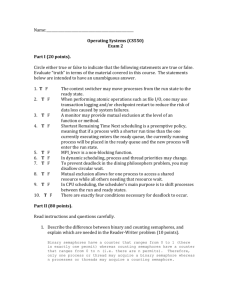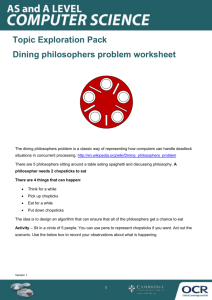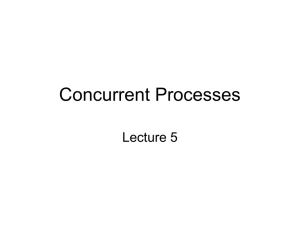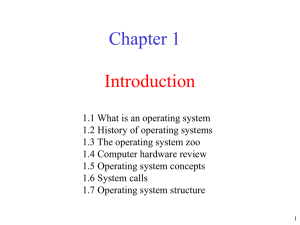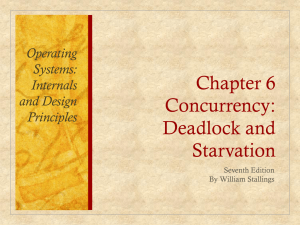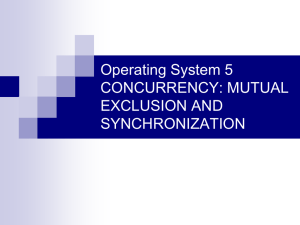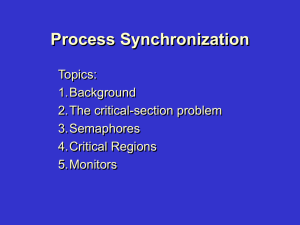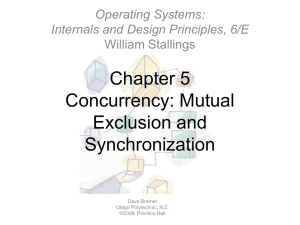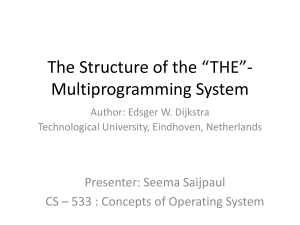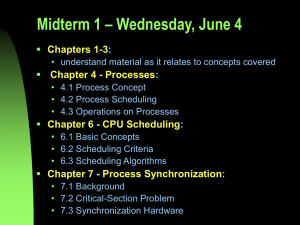Classic IPC - Operating Systems
advertisement
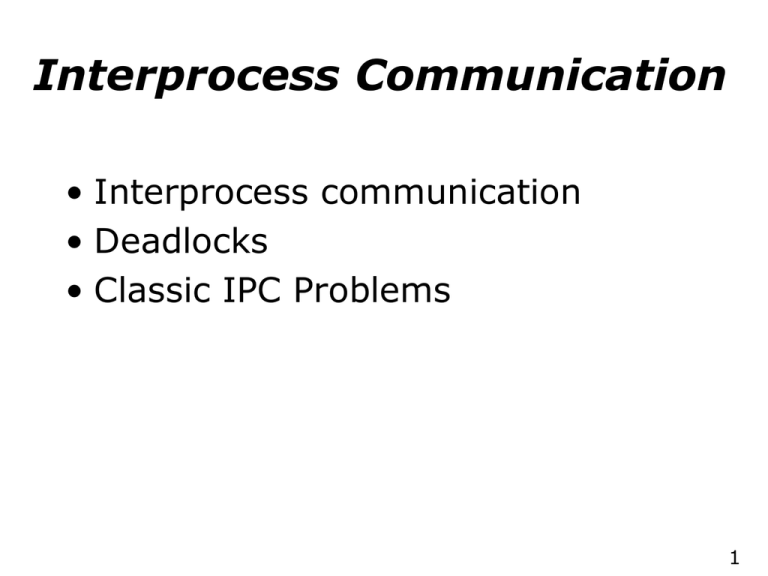
Interprocess Communication
• Interprocess communication
• Deadlocks
• Classic IPC Problems
1
Producer - Consumer Problem
Producer Process
Consumer Process
Produce
Get from buffer
Put in buffer
Consume
BUFFER
• Buffer is shared (ie., it is a shared
variable)
2
Progress in time…..
Producer
p1
1
p2
2
p3
3
Buffer
p4
4
3 instead of 2!
Consumer
1
c1
2
c2
• Both processes are started at the
same time and consumer uses
some old value initially
t
3
A Race Condition
• Because of the timing and which
process starts first
• There is a chance that different
executions may end up with
different results
4
Critical Sections
• Critical Section
– A section of code in which the process
accesses and modifies shared
variables
• Mutual Exclusion
– A method of preventing for ensuring
that one (or a specified number) of
processes are in a critical section
5
Why Processes Need to
Communicate?
• To synchronize their executions
• To exchange data and
information
6
Rules to Form
Critical Sections
1. No two processes may be
simultaneously inside their CS
(mutual exclusion)
2. No assumptions are made about
relative process speeds or number of
CPUs
3. A process outside a CS should not
block other processes
4. No process should wait forever
before entering its CS
7
Mutual Exclusion Problem
Starvation
• Definition
– Indefinitely delaying the scheduling of a process
in favor of other processes
• Cause
– Usually a bias in a systems scheduling policies (a
bad scheduling algorithm)
• Solution
– Implement some form of aging
8
Another Problem
Deadlocks
– Two (or more) processes are blocked
waiting for an event that will never occur
– Generally, A waits for B to do something
and B is waiting for A
– Both are not doing anything so both
events never occur
9
How to Implement
Mutual Exclusion
• Three possibilities
– Application: programmer builds some
method into the program
– Hardware: special h/w instructions
provided to implement ME
– OS: provides some services that can
be used by the programmer
• All schemes rely on some code for
– enter_critical_section, and
– exit_critical_section
10
Application
Mutual Exclusion
• Application Mutual Exclusion is
– implemented by the programmer
– hard to get correct, and very
inefficient
• All rely on some form of busy
waiting (process tests a condition,
set a flag, and loops while the
condition remains the same)
11
Example
• Producer
produce
If lock = 1 loop until lock = 0
lock=1
put in buffer
lock=0
• Consumer
If lock = 1 loop until lock = 0
lock=1
get from buffer
lock=0
consume
12
Hardware ME :
Test and Set Instruction
• Perform an x:=r and r:=1
• x is a local variable
• r is a global register set to 0 initially
• repeat (test-set(x)) until x = 0;
< critical section >
r:= 0;
13
Hardware ME :
Exchange Instruction
• Exchange: swap the values of x and r
• x is a local variable
• r is a global register set to 1 initially
• x:= 0;
repeat exchange(r, x) until x = 1;
< critical section >
exchange(r, x);
Note: r:= 0 and x:= 1 when the process is
in CS
14
Hardware ME
Characteristics
• Advantages
– can be used by a single or multiple
processes (with shared memory)
– simple and therefore easy to verify
– can support multiple critical sections
• Disadvantages
– busy waiting is used
– starvation is possible
– deadlock is possible (especially with
priorities)
15
Another Hardware ME :
Disabling Interrupts
• On a single CPU only one process is
executed
• Concurrency is achieved by interleaving
execution (usually done using interrupts)
• If you disable interrupts then you can be
sure only one process will ever execute
• One process can lock a system or degrade
performance greatly
16
Mutual Exclusion
Through OS
• Semaphores
• Message passing
17
Semaphores
• Major advance incorporated into
many modern operating systems
(Unix, OS/2)
• A semaphore is
–a non-negative integer
–that has two valid operations
18
Semaphore Operations
• Wait(s)
If s > 0 then s:= s - 1
else block this process
• Signal(s)
If there is a blocked process on
this semaphore then wake it up
else s:= s + 1
19
More on Semaphores
• Two types of semaphores
– binary semaphores can only be 0 or 1
– counting semaphores can be any nonnegative integer
• Semaphores are an OS service
implemented using one of the
methods shown already
– usually by disabling interrupts for a very
short time
20
Producer - Consumer Problem:
Solution by Semaphores
Produce
CS
Wait(mutex)
Put in buffer
Signal(mutex)
Wait(mutex)
Get from buffer
Signal(mutex)
Consume
• Initially semaphore mutex is 1
21
Another Example
• Three processes all share a resource on which
– one draws an A
– one draws a B
– one draws a C
• Implement a form of synchronization so that the output
appears ABC
Process A
Process B
Process C
think();
think();
think();
draw_A();
draw_B();
draw_C();
22
• Semaphore b = 0, c = 0;
Process A
Process B
Process C
wait(b);
think();
wait(c);
think();
draw_A();
think();
draw_B();
signal(b);
draw_C();
signal(c);
23
Bounded-Buffer Problem
•
We need 3 semaphores:
1. we need a semaphore mutex to have
mutual exclusion on buffer access.
2. we need a semaphore full to synchronize
producer and consumer on the number of
consumable items.
3. we need a semaphore empty to
synchronize producer and consumer on
the number of empty spaces.
24
Bounded-Buffer Semaphores
• Shared data
semaphore full, empty, mutex;
Initially:
full = 0, empty = n, mutex = 1
25
Bounded-Buffer - Producer Process
do {
…
produce an item in nextp
…
wait(empty);
wait(mutex);
…
add nextp to buffer
…
signal(mutex);
signal(full);
} while (1);
26
Bounded-Buffer - Consumer Process
do {
wait(full)
wait(mutex);
…
remove item from buffer to nextc
…
signal(mutex);
signal(empty);
…
consume the item in nextc
…
} while (1);
27
Notes on Bounded-Buffer Solution
• Remarks (from consumer point of view):
– Putting signal(empty) inside the CS of
the consumer (instead of outside) has no
effect since the producer must always
wait for both semaphores before
proceeding.
– The consumer must perform wait(full)
before wait(mutex), otherwise deadlock
occurs if consumer enters CS while the
buffer is empty.
• Conclusion: using semaphores is a difficult
art ...
28
What is Deadlock?
• Process Deadlock
–A process is deadlocked when it
is waiting on an event which will
never happen
• System Deadlock
–A system is deadlocked when
one or more processes are
deadlocked
29
Necessary Conditions for
a Deadlock
• Mutual Exclusion
–Shared resources are used in a
mutually exclusive manner
• Hold & Wait
–Processes hold onto resources
they already have while waiting
for the allocation of other
resources
30
Necessary Conditions for
a Deadlock (Cont.)
• No Preemption
–Resources can not be
preempted until the process
releases them
• Circular Wait
–A circular chain of processes
exists in which each process
holds resources wanted by the
next process in the chain
31
No Deadlock Situation
If you can prevent at least
one of the necessary
deadlock conditions then
you won’t have a
DEADLOCK
32
The Ostrich Algorithm
• Pretend there is no problem
• Reasonable if
– deadlocks occur very rarely
– cost of prevention is high
• UNIX and Windows takes this
approach
• It is a trade off between
– convenience
– correctness
33
Ways of Handling
Deadlock
• Deadlock Prevention
• Deadlock Detection
• Deadlock Avoidance
• Deadlock Recovery
34
Deadlock Prevention
• Remove the possibility of deadlock
occurring by denying one of the
four necessary conditions:
–Mutual Exclusion
(Can we share
everything?)
–Hold & Wait
–No preemption
–Circular Wait
35
Denying the
“Hold & Wait”
• Implementation
–A process is given its resources on a
"ALL or NONE" basis
–Either a process gets ALL its
required resources and proceeds or
it gets NONE of them and waits
until it can
36
Denying the
“Hold & Wait”
• Advantages
–It works
–Reasonably easy to code
• Problems
–Resource wastage
–Possibility of starvation
37
Denying “No preemption”
• Implementation
–When a process is refused a
resource request, it MUST release
all other resources it holds
–Resources can be removed from a
process before it is finished with
them
38
Denying “No preemption”
• Advantages
–It works
–Possibly better resource utilization
• Problems
–The cost of removing a process's
resources
–The process is likely to lose work it
has done. (How often does this
occur?)
–Possibility of starvation
39
Denying “Circular Wait”
• Implementation
–Resources are uniquely
numbered
–Processes can only request
resources in linear ascending
order
–Thus preventing the circular wait
from occurring
40
Denying “Circular Wait”
• Advantages
– It works
• Problems
– Resources must be requested in
ascending order of resource number
rather than as needed
– Resource numbering must be maintained
by someone and must reflect every
addition to the OS
– Difficult to sit down and just write code
41
Deadlock Avoidance
• Allow the chance of deadlock occur
• But avoid it happening..
• Check whether the next state
(change in system) may end up in
a deadlock situation
42
Banker's Algorithm
• Definitions
–Each process has a LOAN, CLAIM,
MAXIMUM NEED
•LOAN: current number of resources held
•MAXIMUM NEED: total number
resources needed to complete
•CLAIM: = (MAXIMUM - LOAN)
43
Banker’s Problem
Customer
Max. Need
Present Loan
Claim
c1
800
410
390
c2
600
210
390
• Suppose total bank capital is $1000
• Current cash: 1000-(410+210)=380
44
Assumptions
• Establish a LOAN ceiling (MAXIMUM
NEED) for each process
– MAXIMUM NEED < total number of resources
available (ie., capital)
• Total loans for a process must be less
than or equal to MAXIMUM NEED
• Loaned resources must be returned
back in finite time
45
Algorithm
1. Search for a process with a claim that can
be satisfied using the current number of
remaining resources (ie., tentatively grant
the claim)
2. If such a process is found then assume
that it will return the loaned resources.
3. Update the number of remaining resources
4. Repeat steps 1-3 for all processes and
mark them
46
Algorithm
• DO NOT GRANT THE CLAIM if at least one
process can not be marked.
• Implementation
– A resource request is only allowed if it
results in a SAFE state
– The system is always maintained in a
SAFE state so eventually all requests
will be filled
47
Algorithm
• Advantages
– Allows jobs to proceed when a prevention
algorithm wouldn't
• Problems
– Requires there to be a fixed number of
resources
– What happens if a resource goes down?
– Does not allow the process to change its
Maximum need while processing
48
Classical IPC Problems
• Readers and writers problem
– Models access to a database (both read
and write)
• Dining philosophers problem
– Models processes competing for exclusive
access to a limited number of resources
such as I/O devices
• Sleeping barber problem
– Models queuing situations such as a multiperson helpdesk with a computerized call
waiting system for holding a limited
number of incoming calls
49
Readers-Writers Problem
•Any number of reader activities and
writer activities are running.
•At any time, a reader activity may
wish to read data.
•At any time, a writer activity may
want to modify the data.
•Any number of readers may access
the data simultaneously.
•During the time a writer is writing, no
other reader or writer may access the
shared data.
50
Readers-Writers with active
readers
51
Readers-Writers with an active
writer
52
Should readers wait for
waiting writer?
53
Readers-Writers problem
1. The first readers-writers problem,
requires that no reader will be kept
waiting unless a writer has obtained
access to the shared data.
2. The second readers-writers problem,
requires that once a writer is ready, no
new readers may start reading.
3. In a solution to the first case writers may
starve; In a solution to the second case
readers may starve.
54
First Readers-Writers Solution
•readcount counter keeps track of
how many processes are currently
reading.
•mutex semaphore provides mutual
exclusion for updating readcount.
•wrt semaphore provides mutual
exclusion for the writers; it is also
used by the first or last reader that
enters or exits the CS.
55
Dining Philosophers Problem
• Five philosophers are
seated around a circular
table.
• In front of each one is a
bowl of rice.
• Between each pair of
people there is a chopstick
(fork), so there are five
chopsticks.
• It takes two chopsticks
(forks?) to eat rice, so
while n is eating neither
n+1 nor n-1 can be
eating.
56
Dining Philosophers Problem
• Each one thinks for a while, gets
the chopsticks needed, eats, and
puts the chopsticks down again, in
an endless cycle.
• Illustrates the difficulty of
allocating resources among
process without deadlock and
starvation.
57
Dining Philosophers Problem
• The challenge is to grant requests for
chopsticks while avoiding deadlock
and starvation.
• Deadlock can occur if everyone tries to
get their chopsticks at once. Each gets
a left chopstick, and is stuck, because
each right chopstick is someone else’s
left chopstick.
58
Dining Philosophers Solution
• Each philosopher
is a process.
• One semaphore
per fork:
– fork: array[0..4]
of semaphores
– Initialization:
fork[i].count := 1
for i := 0..4
Process Pi:
repeat
think;
wait(fork[i]);
wait(fork[i+1 mod 5]);
eat;
signal(fork[i+1 mod 5]);
signal(fork[i]);
forever
First attempt: deadlock if each philosopher starts by
picking up his left fork (chopstick)!
59
Dining Philosophers Solution
Possible solutions to avoid deadlock:
• Allow at most four philosophers to be
sitting at the table at same time.
• Odd numbered philosopher picks up left
fork first, even one picks up right fork.
60
Weakness of the Semaphore
– The user is expected to write wait and signal in
the right order.
– The user must remember to execute signal for
each exit
– Calls may be spread throughout the program
– The logic may demand that a process must
check and signal his peers.
• Review the logic for the Dining Philosophers solution.
• There have been a wide number of
alternatives proposed.
• Monitors are one common approach
61
Monitors
• A new language construct that includes
synchronization
• Implemented in Java via synchronized
keyword
• Only one process can enter a Monitor (use
the entry points) at a time.
• For example, compiler might generate a
call to a common semaphore on entry:
signal on exit.
• If process P makes a monitor call, and
process Q is in the monitor, P will block
until Q exits
62
Java Example
class Account {
private double balance;
public Account(double deposit) { }
balance = deposit;
public synchronized double getBalance() {
return balance;
}
public synchronized void deposit(double amount) {
balance += amount;
}
public synchronized void withdraw(double amount) {
balance -= amount;
}
}
63
Equivalence
• Monitors and semaphores have
equivalent power
• Anything you can do with Monitors,
you can do with semaphores.
– Proof: we can implement a monitor with a
semaphore
• Anything that you can do with
Semaphores, you can do with Monitors
– Proof: we can implement a semaphore
with a monitor
64
Summary
• We have seen two problems
– Critical Sections - cannot both be modifying
variable
– Synchronization - must define ordering
• Often, our problems are a combination of the
two
– Readers/writers share storage, and readers
should wait if there are writers waiting
• It is difficult to use semaphores correctly.
• While there has been language support for
Monitors for some time, standard UNIX still
only supports semaphore (man sem_open)
65
